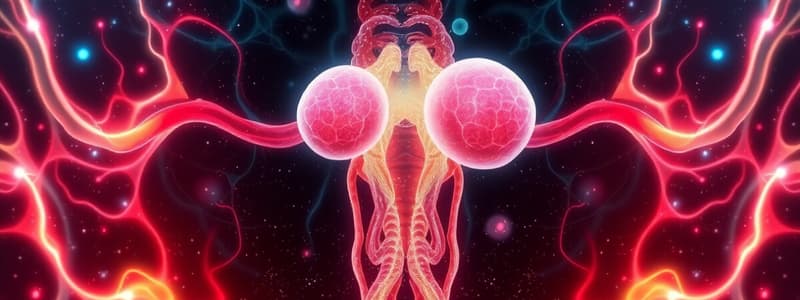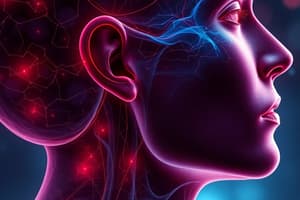Podcast
Questions and Answers
What is the primary cause of central diabetes insipidus?
What is the primary cause of central diabetes insipidus?
- Renal failure
- ADH deficiency due to hypothalamic or posterior pituitary pathology (correct)
- Excessive ADH secretion
- Impaired water reabsorption in the kidneys
Which symptom is specifically indicative of nephrogenic diabetes insipidus?
Which symptom is specifically indicative of nephrogenic diabetes insipidus?
- No response to desmopressin (correct)
- Increased urine osmolality after desmopressin administration
- Seizures due to cerebral edema
- Polyuria and polydipsia
What is a common clinical feature of syndrome of inappropriate ADH (SIADH) secretion?
What is a common clinical feature of syndrome of inappropriate ADH (SIADH) secretion?
- Hyponatremia and low serum osmolality (correct)
- Increased thirst and dehydration
- Polyuria and high urine osmolality
- Hypernatremia and low serum osmolality
What would be a key diagnostic test result for central diabetes insipidus?
What would be a key diagnostic test result for central diabetes insipidus?
Which treatment option is appropriate for syndrome of inappropriate ADH (SIADH) secretion?
Which treatment option is appropriate for syndrome of inappropriate ADH (SIADH) secretion?
What are the common symptoms associated with a prolactinoma in males?
What are the common symptoms associated with a prolactinoma in males?
What is the primary treatment approach for managing functional pituitary adenomas?
What is the primary treatment approach for managing functional pituitary adenomas?
Which type of pituitary adenoma is most associated with gigantism in children?
Which type of pituitary adenoma is most associated with gigantism in children?
What condition may result from loss of more than 75% of pituitary parenchyma?
What condition may result from loss of more than 75% of pituitary parenchyma?
What is the mechanism behind Sheehan syndrome?
What is the mechanism behind Sheehan syndrome?
Which of the following symptoms is most commonly seen in adults with acromegaly?
Which of the following symptoms is most commonly seen in adults with acromegaly?
What is the most significant effect of nonfunctional pituitary adenomas?
What is the most significant effect of nonfunctional pituitary adenomas?
Which hormone is typically elevated in cases of pituitary adenomas that secrete ACTH?
Which hormone is typically elevated in cases of pituitary adenomas that secrete ACTH?
Flashcards
What is ADH (Antidiuretic Hormone)?
What is ADH (Antidiuretic Hormone)?
Hormone produced in the hypothalamus and stored in the posterior pituitary. ADH acts on the kidneys to promote water reabsorption, concentrating urine. It helps regulate water balance in the body.
What is Diabetes Insipidus?
What is Diabetes Insipidus?
A condition where the body cannot produce or respond to ADH properly. This results in excessive water loss, leading to dehydration and concentrated urine.
What is Central Diabetes Insipidus?
What is Central Diabetes Insipidus?
Diabetes Insipidus caused by a lack of ADH production or release from the posterior pituitary. This can be due to tumors, trauma, infection, or inflammation.
What is Nephrogenic Diabetes Insipidus?
What is Nephrogenic Diabetes Insipidus?
Signup and view all the flashcards
What is Syndrome of Inappropriate ADH Secretion (SIADH)?
What is Syndrome of Inappropriate ADH Secretion (SIADH)?
Signup and view all the flashcards
What is a pituitary adenoma?
What is a pituitary adenoma?
Signup and view all the flashcards
What symptoms are caused by nonfunctional pituitary adenomas?
What symptoms are caused by nonfunctional pituitary adenomas?
Signup and view all the flashcards
What symptoms are caused by functional pituitary adenomas?
What symptoms are caused by functional pituitary adenomas?
Signup and view all the flashcards
What is a prolactinoma?
What is a prolactinoma?
Signup and view all the flashcards
What are the effects of growth hormone-producing adenomas?
What are the effects of growth hormone-producing adenomas?
Signup and view all the flashcards
What is hypopituitarism?
What is hypopituitarism?
Signup and view all the flashcards
What is craniopharyngioma?
What is craniopharyngioma?
Signup and view all the flashcards
What is Sheehan syndrome?
What is Sheehan syndrome?
Signup and view all the flashcards
Study Notes
Anterior Pituitary Gland - Pituitary Adenomas
- Benign tumors of the anterior pituitary can be functional (hormone-producing) or nonfunctional (silent).
- Nonfunctional tumors cause mass effects like bitemporal hemianopsia (blindness in outer parts of the visual field) due to optic chiasm compression.
- Nonfunctional tumors also cause hypopituitarism and headaches due to pituitary tissue compression.
- Functional tumors produce hormones with different symptoms depending on the hormone produced.
- Prolactinomas: These are the most common pituitary adenomas. They cause galactorrhea (milk production in non-breastfeeding women) and amenorrhea (loss of menstrual periods) in females, and decreased libido and headaches in males.
- Prolactinoma treatment: Dopamine agonists (like bromocriptine or cabergoline) shrink the tumor and suppress prolactin. Surgery is also an option for larger lesions.
- Growth hormone cell adenomas: These tumors cause gigantism in children (excessive linear bone growth before epiphyses fuse) and acromegaly in adults (excessive bone growth in adulthood, affecting hands, feet, and jaw). Features include enlarged visceral organs and potential dysfunction (e.g., cardiac failure) and enlarged tongues.
- Growth hormone cell adenomas are diagnosed by elevated GH and IGF-1 levels, and lack of suppression of GH by oral glucose tolerance tests. Treatment often includes octreotide (somatostatin analog), GH receptor antagonists, or surgery.
- ACTH cell adenomas lead to Cushing syndrome (see Adrenal Cortex section).
Anterior Pituitary Gland - Hypopituitarism
- Hypopituitarism: Insufficient hormone production by the anterior pituitary, often symptomatizing when over 75% of the pituitary parenchyma (functional tissue) is lost.
- Causes: Pituitary adenomas, craniopharyngiomas (tumors) in children, pituitary apoplexy (bleeding into an adenoma), or Sheehan syndrome (postpartum pituitary infarction).
- Sheehan Syndrome: Pregnancy-related infarction, due to significant pituitary growth during pregnancy without parallel increases in blood supply. Significant blood loss during childbirth can trigger infarction.
Posterior Pituitary Gland - Basic Principles
- Antidiuretic hormone (ADH) and oxytocin are produced in the hypothalamus and stored in the posterior pituitary for release.
- ADH regulates water reabsorption in the kidneys
- Oxytocin controls uterine contractions and breast milk release.
Posterior Pituitary Gland - Central Diabetes Insipidus
- Central Diabetes Insipidus: ADH deficiency due to hypothalamic or posterior pituitary pathology (trauma, infection etc).
- Symptoms: Excessive thirst and urination, polyuria and polydipsia with risk of dehydration, elevated serum sodium and osmolality.
- Diagnosis: Water deprivation test to assess urine osmolality response. Treatment: Desmopressin (ADH analog).
Posterior Pituitary Gland - Nephrogenic Diabetes Insipidus
- Nephrogenic Diabetes Insipidus: Impaired kidney response to ADH.
- Causes: Inherited mutations or drugs like lithium and demeclocycline.
- Symptoms: Similar to central diabetes insipidus, but there's no response to desmopressin.
Studying That Suits You
Use AI to generate personalized quizzes and flashcards to suit your learning preferences.
Related Documents
Description
Explore the characteristics and effects of anterior pituitary gland adenomas in this quiz. Learn about the differences between functional and nonfunctional tumors, their symptoms, and treatment options. Test your knowledge on prolactinomas and growth hormone cell adenomas.




